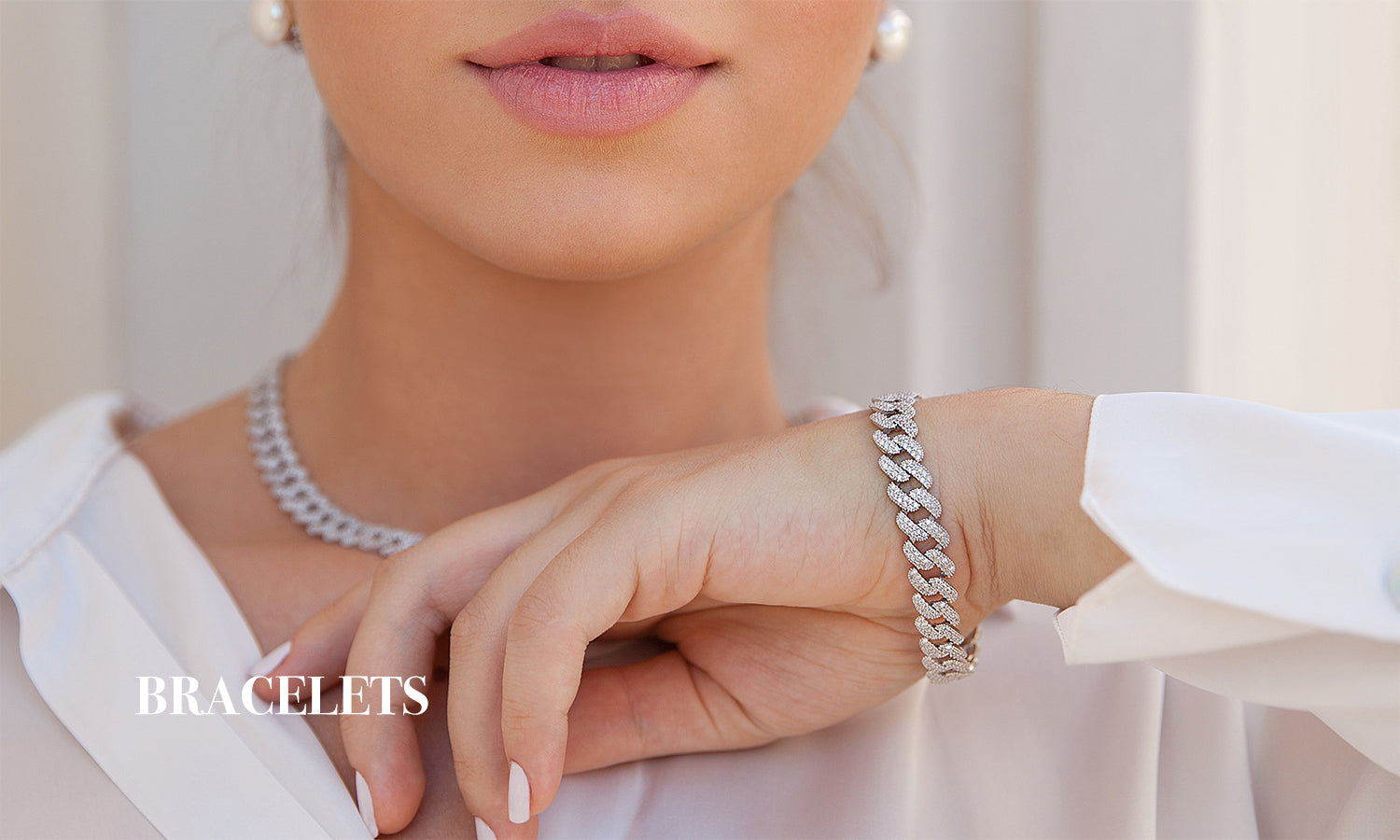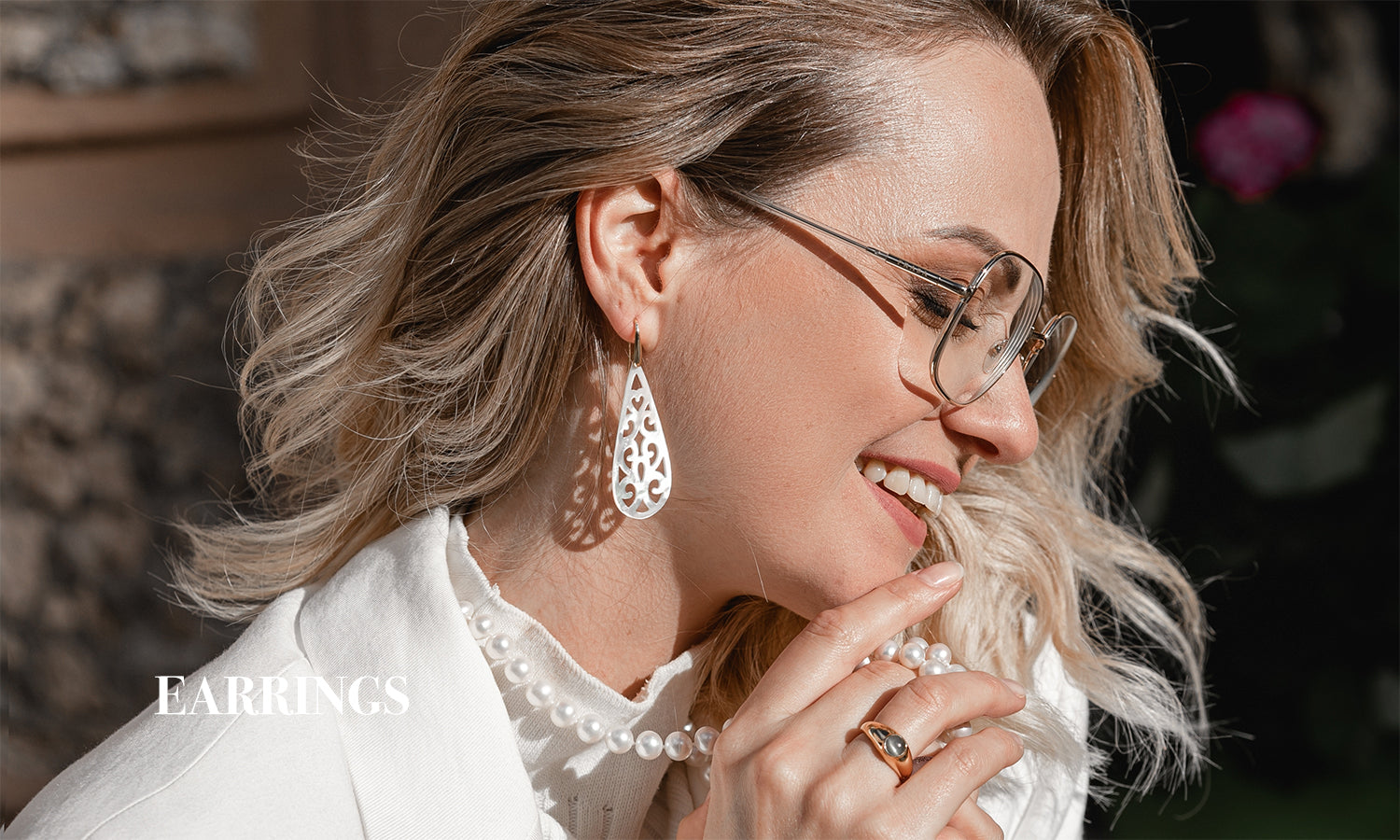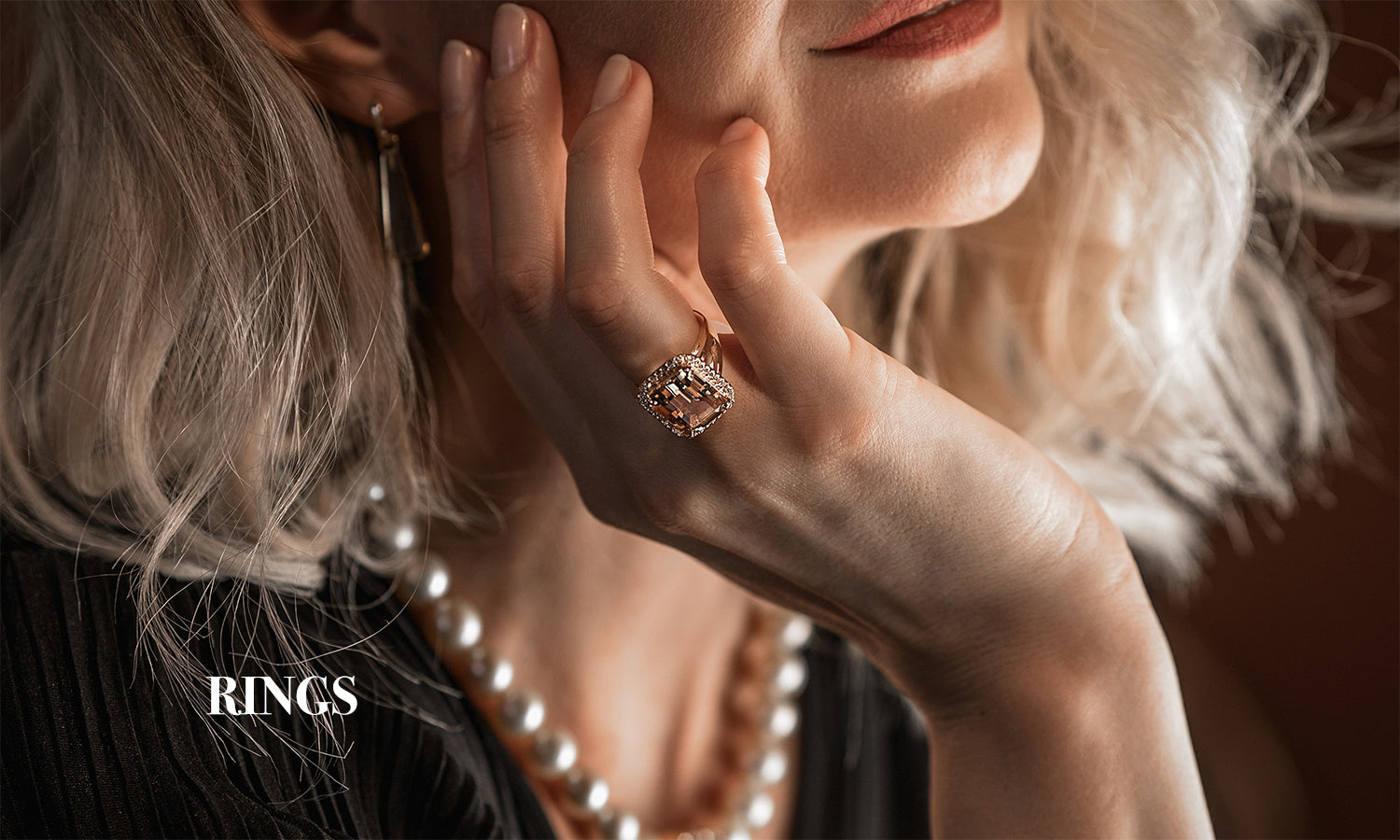
Differences between types of artistic Gold at Planderful(white, yellow, 14k, 18k) Is there "pure" Gold?
Share
When it comes to Gold, there are more options than you may think. While Gold is a naturally occurring element, how it is combined with other metals, such as silver, copper, and palladium, can affect its color and durability. This blog will explore the differences between white, yellow, 14k, and 18k gold.
14K and 18K Gold refers to the amount of pure Gold in the alloy, with 14K gold being 58.3% pure gold and 18K Gold being 75% pure gold. Pure Gold is 24K gold, 100% pure gold, and contains no other metals.
What is Pure Gold?

Pure Gold is a valuable precious metal that has been prized for its beauty, malleability, and rarity for thousands of years. It is one of the most sought-after metals in the world due to its attractive appearance, malleability, and resistance to corrosion. Gold is also popular due to its enduring value and limited supply.
Pure Gold is a naturally occurring metallic element with a distinct yellowish-orange color and is extremely malleable and ductile. Its atomic number is 79, and its melting point is 1064.43 °C (1947.93 °F). Pure Gold is approximately 19.3 times heavier than an equal volume of water.
Pure Gold is usually produced through smelting, which involves heating a mixture of gold ore and other substances such as mercury, lead, and borax to a high temperature. This process separates the Gold from the impurities and results in a pure form of the metal. Gold can also be produced through electrolysis, which uses electricity to separate the Gold from other substances.
The purity of Gold is measured in karats, with 24-karat gold being the purest form. 24-karat Gold is also known as "fine gold" and is the standard for measuring gold jewelry's purity. 18-karat gold, 75% pure gold, is commonly used in jewelry, while 14-karat gold, 58.3% pure gold, is often used for coins and other items. Gold is also sometimes alloyed with other metals, such as silver, copper, and zinc, to create different colors, such as white and yellow Gold.
Gold has been used for many purposes throughout history, including to make coins, jewelry, and other decorative items. Gold has also gained popularity recently as a store of value due to its limited supply and enduring value.
Pure Gold is an extremely valuable and desirable metal that has been treasured for thousands of years. As a result, Gold has become an increasingly popular investment asset, and its limited supply has made it a viable hedge against inflation and currency devaluation.
Mining and Refining Pure Gold
Mining for Gold is the process of extracting Gold from the earth. The gold ore is then processed to extract the pure Gold. This is done using a variety of processes and techniques, such as crushing, milling, and chemical extraction. The process of extracting Gold from ore is known as gold refining.
Refining Gold involves several steps. The first step is to crush the ore, which is put through a grinding machine to create a powder. The powder is then mixed with water and chemicals to create a slurry. The slurry is then heated to a high temperature, which causes the Gold to separate from the other substances. The Gold is then filtered out and collected.
The Gold is processed further to remove any impurities and create 99.99% pure gold. This is done through fire assaying, which involves heating the Gold to 1,800 degrees Fahrenheit and filtering out any impurities, such as silver and copper. The Gold is then put through an electrolytic process to create a 99.999% pure gold bar.
Gold has been prized for its beauty, malleability, and rarity for thousands of years, and it remains one of the most sought-after metals in the world.
Gold is a popular investment asset due to its enduring value, limited supply, and corrosion resistance. It is also an excellent form of currency due to its portability and divisibility. Pure Gold is an extremely valuable and desirable metal that has been treasured for thousands of years.
Assay Testing for Pure Gold

Assay testing is an important part of gold production, as it helps to ensure that the Gold is pure and of the highest quality. Assay testing is done to measure the amount of Gold in the ore. The test includes several methods, such as fire assaying, X-ray fluorescence, and atomic absorption spectroscopy.
Fire assaying is the oldest method used for assay testing, and it involves heating the gold ore to 1,800 degrees Fahrenheit, which causes the Gold to separate from other substances. The Gold is then filtered out and collected. X-ray fluorescence is used to measure the amount of Gold in the ore, while atomic absorption spectroscopy is used to measure the number of other elements in the ore.
Assay testing helps to ensure that the Gold is pure and of the highest quality. It is important to perform the tests regularly to ensure that the Gold is pure and of the highest standard. Assay testing is also used to determine the value of Gold, as the purity of the Gold is directly related to its value.
Appraising Pure Gold
An appraisal is a process of determining the value of an item, such as Gold. Appraisers use a variety of methods to appraise Gold, such as analyzing the Gold's purity, weight, and market value.
The purity of Gold is determined through assay testing, which measures the amount of Gold in the ore. The weight of the Gold is determined by weighing the Gold on a scale. The market value of Gold is determined by looking at the current spot price of Gold, which is the price per ounce of Gold.
Storing Pure Gold
Storing Gold is an important part of protecting your investment. Gold should be stored in a secure location, such as a safe or bank vault, to protect it from theft and damage.
Gold can also be stored in a depository, a secure facility insured and monitored by professionals. Depositories also offer additional services such as storage, transport, and insurance.
Investing in Pure Gold
Gold has become an increasingly popular investment asset in recent years, with many investors viewing it as a hedge against inflation and currency devaluation. Gold is also a great store of value due to its enduring value and limited supply.
Investing in Gold is a great way to diversify your portfolio and protect against inflation. Investors can buy Gold through coins, bars, and other products, such as exchange-traded funds (ETFs). Gold can also be purchased through futures contracts and options.
Understanding the Benefits of Pure Gold
- Pure Gold is an attractive and durable metal resistant to tarnishing and corrosion.
- Pure Gold is a valuable investment asset that can protect against inflation and currency devaluation.
- Gold has an enduring value and a limited supply, making it a great store of value.
- Gold can be bought in many forms, including coins, bars, ETFs, futures contracts, and options.
- Gold can be stored in a secure location, such as a bank vault or depository.
Identifying Pure Gold Jewelry and Collectibles
Identifying pure gold jewelry and collectibles can be done by examining the item for markings, such as a hallmark or stamp. The hallmark or stamp will indicate the purity of the Gold, such as "24K" for pure Gold or "18K" for 18-karat gold. Additionally, pure gold jewelry and collectibles will typically have a yellowish-orange color.
Another way to identify pure Gold is to use a specific gravity test. A specific gravity test is used to measure the density of the Gold, which is higher for pure Gold than for gold alloys. Additionally, pure Gold will feel heavier than gold alloys due to its higher density.
Finally, a magnet can be used to identify pure Gold. Gold is not magnetic, so if the item sticks to the magnet, it is not pure Gold.
Is there "pure" Gold?
Yes, there is "pure" Gold. Pure Gold is a naturally occurring metallic element with a distinct yellowish-orange color and is extremely malleable and ductile. Pure Gold is usually produced through smelting, which involves heating a mixture of gold ore and other substances such as mercury, lead, and borax to a high temperature. This process separates the Gold from the impurities and results in a pure form of the metal. The purity of Gold is measured in karats, with 24-karat gold being the purest form. Pure Gold is an extremely valuable and desirable metal that has been treasured for thousands of years.
What is White Gold?

White Gold is a gold alloy usually made of Gold and some white metals, such as silver, palladium, and nickel. It is usually used for jewelry or decorative accents on watches and other items. White Gold is usually plated with rhodium, which gives it a bright, shiny finish.
History of White Gold
White Gold was first developed in the early 20th century by a German jeweler, Carl Fabergé. He created the alloy to be used as a less expensive alternative to platinum, which was then the most popular metal for jewelry. White Gold gained popularity in the 1920s and 1930s in the United States and has remained popular ever since.
Advantages and Disadvantages of White Gold
Advantages: White Gold is less expensive than platinum and highly durable. It also has an attractive bright, shiny finish that can be enhanced with rhodium plating.
Disadvantages: White Gold is softer than other gold alloys so it can scratch or dent more easily. In addition, it can tarnish over time, so it requires regular cleaning and polishing.
The Difference Between White Gold and Yellow Gold
The main difference between white Gold and yellow Gold is the color. White Gold is a pale silver color, while yellow Gold is a golden yellow color. White Gold is also usually plated with rhodium, which gives it a bright, shiny finish.
Caring for White Gold Jewelry
- Clean your white gold jewelry regularly with a soft cloth, mild soap, and water.
- Store your white gold jewelry in a cool, dry place, away from sunlight, heat, and humidity.
- Have your white gold jewelry professionally inspected and polished every six months.
- Avoid contact with harsh chemicals, such as chlorine and ammonia, which can damage the finish of your white gold jewelry.
- Have your white gold jewelry re-plated with rhodium every few years to maintain its shine.
The Popularity of White Gold
White Gold is a popular choice for engagement rings and wedding bands, as it is less expensive than platinum and has a bright, shiny finish. White Gold is also used to make watches, earrings, necklaces, and other items. Its popularity is due to its durability, attractive finish, and affordability.
White Gold vs. Platinum
White Gold and platinum are both popular metals for jewelry, but they have some significant differences. White Gold is less expensive than platinum and has a bright, shiny finish. However, it is also softer than platinum and can easily scratch or dent. Platinum is more durable and expensive than white Gold, but it also has a more subtle finish.
White Gold Alloys for Jewelry
White gold alloys for jewelry usually contain Gold, silver, palladium, and nickel. The exact proportions of these metals vary depending on the desired color and strength of the alloy. The most popular white gold alloy is 14K, which contains 58.3% gold, 28.3% silver, 8.3% palladium, and 5.1% nickel. Higher karat values, such as 18K and 22K, contain more Gold and less of the other metals.
Pros and Cons of White Gold Engagement Rings
Pros: White gold engagement rings are less expensive than platinum, they have a bright, shiny finish, and they are durable. They are also versatile enough to go with various wedding bands and styles.
Cons: White gold engagement rings can scratch or dent more easily than other metals, requiring regular cleaning and polishing. They can also tarnish over time, so they must be re-plated with rhodium every few years to maintain their shine.
What is Yellow Gold?

Yellow Gold is a gold alloy created by mixing pure Gold with metals such as copper and zinc to give it a yellow hue.
The Benefits of Yellow Gold
- It is durable and strong.
- It can be resized and shaped into many different styles.
- It is hypoallergenic, making it a great choice for sensitive skin.
- It is a timeless classic that is perfect for any occasion.
- It is less expensive than other types of Gold, such as white Gold and platinum.
The History of Yellow Gold
Yellow Gold has a long and illustrious history. It is believed that humans have been using Gold for jewelry since at least 4000 BC. Gold was a symbol of wealth, power, and status in ancient Egypt and Mesopotamia. Ancient Egyptians used yellow Gold in jewelry and amulets to ward off evil spirits and protect them from harm.
In the Middle Ages, Gold was used to decorate religious artifacts and buildings. Goldsmiths began to craft intricate and ornate jewelry from yellow Gold during the Renaissance. It was also used in coins and other forms of currency.
Today, yellow Gold is still a popular choice for jewelry and engagement rings. It is a timeless classic that is perfect for any occasion.
Buying Yellow Gold Jewelry
- Consider your budget. Yellow Gold is usually less expensive than other types of Gold, such as white Gold and platinum.
- Consider the karat of the Gold. The higher the karat, the purer the Gold.
- Look for quality craftsmanship. Make sure the piece is well-made, and the stones are set properly.
- Check for hallmarks or stamps. This will tell you the karat of the Gold and the maker.
- Consider the design. Choose a piece that reflects your style and personality.
Caring for Yellow Gold Jewelry
- Store your yellow gold jewelry in a soft, dry cloth or box.
- Clean your jewelry with a soft, lint-free cloth.
- Avoid using harsh chemicals and abrasives on your jewelry.
- Remove your jewelry before swimming or bathing.
- Have your jewelry checked and polished by a jeweler every few years to keep it looking its best.
Understanding Karats and Fineness in Yellow Gold
The karat of the Gold is an indication of its purity. It is measured on a scale from 0 to 24, with 24 being the purest. The fineness of the Gold is the percentage of pure Gold in the alloy.
For example, 18K gold is 75% pure gold and 25% other metals. 14K Gold is 58.5% pure gold and 41.5% other metals.
Popular Yellow Gold Jewelry Styles
- Classic Solitaire Engagement Ring.
- Stud Earrings.
- Necklaces.
- Bracelets.
- Rings.
Choosing Yellow Gold for Engagement Rings
Yellow Gold is a timeless classic that is perfect for any occasion. It is perfect for those who want a traditional style and is a great choice for engagement rings. It is durable and strong so it will last many years. It is also less expensive than other types of Gold, so it is a great choice for those on a budget.
Yellow Gold Jewelry Design Inspiration
- Vintage-Inspired.
- Nature-Inspired.
- Geometric.
- Animal-Inspired.
- Minimalist.
What is 14K Gold?

14K Gold is a type of gold alloy made up of 58.3% pure gold and 41.7% other metals such as silver, copper, nickel, and zinc. It is a popular metal for making jewelry and other decorative items because of its attractive yellow color and durability. 14K gold is considered a mid-range gold in terms of purity, with 18K gold being the highest purity and 10K gold being the lowest.
What is the Color of 14K Gold?
14K gold has a yellow hue, but its color can vary depending on the other metals used in the alloy. For example, 14K white gold has a silver-gray hue, and 14K Rose Gold has a pinkish hue.
How to Identify 14K Gold?
One of the easiest ways to identify 14K gold is by looking for a stamp that indicates the metal's purity, such as "14K" or "585." This stamp is usually found inside a piece of jewelry or the back of a charm. You can also use an acid test to identify 14K gold. This involves using a special acid solution on a piece of gold jewelry to see if it leaves a yellow or gold streak.
Advantages of 14K Gold
- Durability: 14K gold is a harder metal than other gold alloys, making it more durable and less prone to scratches and dents.
- Cost: 14K Gold is less expensive than 18K gold and is a great choice for those who want the look of Gold without breaking the bank.
- Color Options: 14K gold is available in various colors, including yellow, white, and rose Gold.
Disadvantages of 14K Gold
- Alloy Content: While 14K gold is still relatively high, its lower purity means it is more prone to tarnishing.
- Lower Purity: Since 14K gold has a lower purity than 18K gold, it may not be suitable for certain types of jewelry that require a higher purity gold.
- Less Value: 14K gold has less gold content than other gold alloys, so it has a lower resale value than 18K gold.
Care and Maintenance of 14K Gold
- Clean with Soap and Water: To keep your 14K gold jewelry looking its best, use mild soap and lukewarm water to clean it.
- Avoid Chemicals: To prevent damage to 14K gold, avoid using harsh chemicals such as alcohol and chlorine.
- Store Separately: Store 14K gold jewelry separately from other jewelry to prevent scratches and damage.
- Have it Checked Regularly: Have your 14K gold jewelry checked by a jeweler or goldsmith every few years to ensure it is in good condition.
Jewelry Made with 14K Gold

14K gold is a popular choice for making jewelry because of its attractive color, durability, and affordability. It is often used to make rings, earrings, bracelets, necklaces, charms, and other jewelry pieces. 14K Gold can make coins, watches, and other decorative items.
Popular Uses for 14K Gold
- Wedding Bands: 14K gold is a popular choice for wedding bands because of its durability and affordability.
- Jewelry: 14K gold is often used to make pendants, earrings, charms, and other jewelry pieces.
- Coins: 14K gold is sometimes used to make coins, such as the American Eagle gold coins.
- Watches: 14K gold is often used to make luxury watches like Rolex watches.
Price of 14K Gold
The price of 14K gold depends on the current market price, which fluctuates daily. As of June 2020, 14K gold is around $25 per gram.
Jewelry Hallmark for 14K Gold
In some countries, 14K gold jewelry must be stamped with a hallmark to indicate purity. The hallmark for 14K gold is usually a "585" or "14K" stamp, although the exact stamp may vary by country.
What is 18K Gold?
18K Gold is an alloy of Gold and other metals, such as copper, zinc, and silver. It is typically 75% pure gold, making it a popular choice for jewelry, coins, and other luxury items.
The Allure of 18K Gold
18K Gold is popular for its rich yellow color and ability to be crafted into various shapes and designs. Adding other metals increases strength and makes it more durable than pure Gold. 18K Gold is also more affordable than pure Gold, making it a popular choice for those looking to buy fine jewelry on a budget.
Benefits of 18K Gold
- Durability: 18K Gold is more durable than pure Gold, making it ideal for items that will be worn every day.
- Aesthetics: The yellow color of 18K Gold is often more vibrant than pure Gold, making it a popular choice for jewelry and other luxury items.
- Affordability: 18K Gold is more affordable than pure Gold, making it a great choice for those looking to buy fine jewelry on a budget.
Caring for 18K Gold Jewelry
- Clean your 18K Gold jewelry regularly with a soft cloth or mild detergent and warm water.
- Store safely: Store your 18K Gold jewelry in a dry and cool place, away from direct sunlight and moisture.
- Avoid contact with chemicals: Avoid contact between your 18K Gold jewelry and chemicals, such as cleaning products, perfumes, and lotions.
18K Gold Jewelry Styles
- Rings: 18K Gold rings are popular for men and women. They can be crafted into various styles and designs, such as solitaire, halo, and vintage.
- Bracelets: 18K Gold bracelets are available in various styles and designs, such as bangles, charm bracelets, and cuff bracelets.
- Earrings: 18K Gold earrings come in various styles, such as studs, hoops, and drops.
- Necklaces: 18K Gold necklaces are available in various styles, such as pendants, chokers, and chains.
Popular 18K Gold Pieces
- Rolex Day-Date President: The Rolex Day-Date President is a timeless and classic 18K Gold watch.
- Cartier Love Bracelet: The Cartier Love Bracelet is a classic 18K Gold bracelet with a timeless design.
- Tiffany & Co. Elsa Peretti Diamonds by the Yard Necklace: The Tiffany & Co. Elsa Peretti Diamonds by the Yard Necklace features diamonds set in 18K Gold for a luxurious and timeless look.
18K Gold Price Guide
The price of 18K Gold can vary depending on the item's quality, type, and design. Generally, 18K Gold jewelry ranges from $500 to $10,000.




